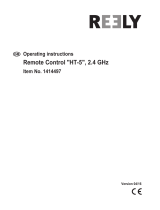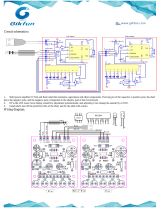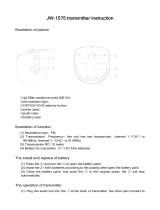Page is loading ...

Operating Instructions
Pistol grip system „GT4 EVO“ 2,4 GHz
Item No. 1410409
Version 10/16

2
Table of Contents
Page
1. Introduction .......................................................................................................................................................... 4
2. Use in accordance with the intended purpose ..................................................................................................... 4
3. Product description .............................................................................................................................................. 5
4. Scope of delivery .................................................................................................................................................5
5. Explanation of symbols ........................................................................................................................................ 6
6. Safety notes .........................................................................................................................................................6
6.1 General information ..................................................................................................................................6
6.2 Operation ..................................................................................................................................................7
7. Safety notes regarding the LiPo battery pack ...................................................................................................... 8
8. Charging the LiPo battery pack ...........................................................................................................................9
9. Operating elements of the transmitter ...............................................................................................................10
10. Starting up the transmitter ................................................................................................................................. 11
10.1 Switching on the transmitter.................................................................................................................... 11
10.2 Checking and setting the digital trimming ............................................................................................... 11
11. Starting up the receiver ......................................................................................................................................13
11.1 Receiver connection ...............................................................................................................................13
11.2 Installing the receiver .............................................................................................................................. 15
11.3 Installing the servo .................................................................................................................................. 15
11.4 Binding function ......................................................................................................................................16
12. Connecting a rotation sensor .............................................................................................................................17
12.1 General Information ................................................................................................................................17
12.2 Temperature Sensor ...............................................................................................................................17
12.3 Voltage Sensor........................................................................................................................................17
12.4 Speed Sensor .........................................................................................................................................17
12.5 Sensor Connections................................................................................................................................18
12.6 Conguration/DisplayoftheSensors....................................................................................................18
13. Checking the steering and drive function ...........................................................................................................19
13.1 Checking the steering function................................................................................................................19
13.2 Checking the drive function.....................................................................................................................20
14. Programming the remote control ......................................................................................................................... 21
14.1 Programming the remote control ............................................................................................................21
14.2 Symbol explanation.................................................................................................................................22
14.3 Operating the LC touchscreen display ....................................................................................................22

3
Page
15. Main menu settings ............................................................................................................................................23
15.1 Main menu settings .................................................................................................................................23
15.2 “Reverse” function...................................................................................................................................24
15.3 “End points” function ............................................................................................................................... 25
15.4 “Subtrims” function ..................................................................................................................................26
15.5 “Steering exponential” function ...............................................................................................................27
15.6 “Steering speed” function ........................................................................................................................27
15.7 “Steering mix” function ............................................................................................................................ 28
15.8 “Throttle neutral” function ........................................................................................................................29
15.9 “Throttle exponential” function ................................................................................................................30
15.10 “Throttle curve” function .......................................................................................................................... 30
15.11 “A.B.S.” function ......................................................................................................................................31
15.12 “Throttle speed” function ......................................................................................................................... 32
15.13 “Throttle middle position” function ........................................................................................................... 33
15.14 “Throttle idle up” function ........................................................................................................................33
15.15 “Engine cut” function ............................................................................................................................... 34
15.16 “Boat mode” function...............................................................................................................................34
15.17 “Brake mixing” function ...........................................................................................................................35
15.18 “Mixes” function.......................................................................................................................................35
15.19 “Displayservos”function.........................................................................................................................37
15.20 “Race timer” function...............................................................................................................................37
15.21 “Keys function” function ..........................................................................................................................38
15.22 “Models” function ....................................................................................................................................39
15.23 “S.V.C.” function ...................................................................................................................................... 40
15.24 “RX setup” function .................................................................................................................................41
15.25 “Spectrum analyzer” function .................................................................................................................. 44
15.26 “System” function .................................................................................................................................... 45
15.27 “Warning Signals” function ...................................................................................................................... 47
15.28 “Change Grip Shell” function...................................................................................................................47
16. Maintenance and care .......................................................................................................................................48
17. Disposal ............................................................................................................................................................. 48
17.1 General information ................................................................................................................................48
17.2 Batteries and battery packs ....................................................................................................................48
18. Eliminating faults ................................................................................................................................................48
19. Technical data ....................................................................................................................................................50
19.1 Transmitter .............................................................................................................................................. 50
19.2 Receiver ..................................................................................................................................................50
20. Declarationofconformity(DOC) ........................................................................................................................50

4
1. Introduction
DearCustomer,
We thank you for purchasing this product.
Thisproductcorrespondstolegal,nationalandEuropeanrequirements.
Inordertoensurethatthisstatusismaintainedalongwiththesafeoperationoftheproduct,theusermustobserve
these operating instructions!
These operating instructions belong to this product. They contain important notes regarding the initial start
up and handling of the product. Pay attention to this information. It also applies when the product is passed
on to a third party.
Forthisreason,keeptheseoperatinginstructionssafeforre-reading!
All of the contained company names and product names are trademarks of the relevant owner. All rights reserved.
If there are any technical questions, please contact:
International: www.conrad.com/contact
United Kingdom: www.conrad-electronic.co.uk/contact
2. Use in accordance with the intended purpose
The4-channelremoteisintendedexclusivelyforprivateuseinmodelconstructionanddesignedwiththeoperating
timesassociatedwiththisuse.Thissystemisnotdesignedforindustrialuse,forexample,forcontrollingmachines
or systems.
Anyuseotherthantheonedescribedabovemayleadtodamagetotheproductwiththeassociatedrisks,forexamp-
le,short-circuiting,re,electricshocketc.Theremotecontrolsystemmaynotbetechnicallymodiedorconverted!
The safety notes must be observed!
Pay attention to all safety notes given in these operating instructions. These contain important information
regarding the handling of the product.
You,andyoualone,areresponsibleforthesafeoperationofyourremotecontrolandyourmodel!

5
3. Product description
Withthe4-channelremotecontrolyouhavearadioremotecontrolsystemideallysuitedtomodelvehiclesormodel
boats. The two proportional control channels enable driving and steering functions to be controlled independently of
each other.
Inaddition, you havetwofurtherswitching channelavailable.Thesecanbe usedtooperatespecial functionsor
gears.
The ergonomically shaped housing sits comfortably in the hand and enables convenient operation of the transmitter
as well as safe control of the model.
WherenoBECspeedcontrollerisused,thereceiverpowersupplyrequires4mignonbatteries(e.g.itemno.:652507,
packof4,order1)andadditionallyamatchingbatteryboxwithon/offswitch.Alternatively,youcanalsoinsertarea-
dyconguredreceiverbattery(recommended).Youneedamatchingon/offswitchforthis.Formatchingaccessories,
see our catalogues or www.conrad.com.
4. Scope of delivery
• RemoteControlTransmitter
• Speedsensorwithmagnet
• Remotecontrolreceiver
• VoltageSensor
• Programmingplug
• Temperaturesensor
• USBcable
• Gripshell
• Adaptercableforsensors
• LiPorechargeablebattery
• Operatinginstructions
Up-to-date Operating Instructions:
1. Open www.conrad.com/downloads in a browser or scan the displayed QR
code.
2. Select document type and language and enter the item number into the search
eld.Aftersubmittingthequeryyoucandownloaddisplayedrecords.

6
5. Explanation of Symbols
Thesymbolwiththeexclamationmarkdrawsyourattentiontoparticularriskswithregardtohandling,use
or operation.
The arrow symbol represents special tips and operating notes.
6. Safety notes
The warranty/guarantee is voided In the event of damages caused by not observing these operating
instructions. We accept no liability for subsequent damages!
We accept no liability for property damage or injuries caused by improper handling or by not ob-
serving the safety notes! In such instances, the warranty/guarantee is voided. Normal wear and tear
caused by operation and accidental damaged are not covered by the warranty and guarantee (e.g.
broken receiver antenna, broken receiver housing etc.).
DearCustomer,Thesesafetyinstructionsarenotjustdesignedtoprotecttheproduct,theyarealsoforyourown
safetyandthatofotherpeople.Forthisreason,pleasereadthischapterthroughverycarefullybeforestartingto
operate the product!
6.1 General information
Caution, important note!
Whenoperatingamodel,propertydamageand/orinjuriesmaybecaused.
Ensurethatyouaresufcientlycoveredbyyourinsurancefortheoperationofthemodel,e.g.bymeansof
liabilityinsurance.Ifyoualreadyhavealiabilityinsurance,checkwithyourinsurerbeforestartingtooperate
your model whether the operation of the model is covered or not.
• Forsafetyandauthorisationreasons,ownconversionsand/ormodicationstotheproductarenotpermitted.
• Theproductisnotatoyanditisnotsuitableforchildrenunder14yearsofage.
• Theproductmaynotbecomedamporwet.
• Alwaysswitchonthetransmitterrst,thenthereceiversystem.Otherwise,themotormaystartupuncontrolledwith
an electrically powered model. A motor that is already running may run uncontrolled to full throttle in a model with
combustionengine.Inbothcases,unintendedpropertydamageand/orinjurymayoccur.
• Donotleavepackagingmateriallyingaroundcarelessly.Thismaybecomeadangeroustoyforchildren.

7
• Beforeeachstartup,checkthefunctionalsafetyofyourmodelandtheremotecontrolsystem.Payattentionto
visibledamages,forexample,defectivepluggedconnectionsordamagedcables.Allmovingpartsshouldmove
easily,butshouldnotdisplayplayintheirbearings.
• Ifthereareanyquestionsthatcannotbeclariedwiththeassistanceoftheseoperatinginstructions,pleasecontact
us(forcontactinformation,seeChapter1)oranotherspecialist.
The operation and use of remote controlled models is something that must be learned! If you have never
remotelycontrolledamodel,startverycarefullyandfamiliariseyourselfwiththeresponsesofthemodelto
the remote control commands. Be patient!
6.2 Operation
• Ifyoudonothavesufcientknowledgeofthehandlingofremotelycontrolledmodels,pleaseconsultanexperienced
model operator or model construction club.
• Whenstartingup,alwaysswitchthetransmitteronrst.Thenyoumayswitchthereceiverinthemodelon.Other-
wise,themodelmayreactinanunpredictableway!Avoidattemptingto“point”thetipoftheantennaatthemodel.
• Beforeoperating,checkwiththemodelatastandstilltoensurewhetheritrespondsasexpectedtotheremote
control commands.
• Whenoperatingamodel,payattentiontoensurethatnobodypartsorobjectsarelocatedinthedangerzoneof
engines or other rotating drive parts.
• Improperoperation may cause serious injury orproperty damage!Alwaysensure directvisual contact withthe
model and do not operate it at night.
• Onlycontrolyourmodelwhenyourresponsesarenotinuenced.Ifyouaretired,orundertheinuenceofalcohol
ormedication,youmayreactincorrectly.
• Onlyoperateyourmodelinanareainwhichyoudonotendangerotherpeople,animalsorobjects.Operateonlyon
privatepremisesorareasspecicallysetasideforthispurpose.
• Intheeventofafault,immediatelyceaseoperatingyourmodelandeliminatethecauseofthefaultbeforeusingthe
model again.
• Donotoperateyourremotecontrolsysteminastorm,underhigh-voltagepowerlinesorinthevicinityofradio
masts.
• Alwayskeeptheremotecontrol(transmitter)switchedonaslongasthemodelisinoperation.Afterendingyour
modeluse,alwaysswitchtheengineoffrst,thenswitchoffthereceivingsystem.Thenyoumayswitchremote
control transmitter off.
• Protecttheremotecontrolsystemfromdampandheavysoiling.
• Donotexposethetransmittertodirectsunlightorgreatheatoveralongerperiodoftime.
• Ifthebatteryintheremotecontrolisweak,therangewillbereduced.Ifthereceiverbatteryisweak,themodelwill
notrespondcorrectlytotheremotecontrol.Inthiscase,stopoperatingimmediately!Rechargethebatterypack!
• Donottakeriskswhenoperatingtheproduct!Yourownsafetyandthatofyoursurroundingsdependuponyour
responsible handling of the model.

8
7. Safety notes regarding the LiPo battery pack
• TheLiPobatterypack(LithiumPolymer)isnotforusebychildren.
• TheLiPobatterymayneverbeshort-circuited,dismantledorthrownintore.Thereisariskofexplosion!
• OnlychargetheLiPobatterypackinthetransmitter,neveruseanotherchargertocharge.
• OperatethetransmitterusingthesuppliedLiPobatterypackonly.
• IftheLiPobatterypackdistortsduringcharging,interruptthechargingprocess.
• TheLiPobatterypackmaynotbeovercharged.Interruptthechargingprocessimmediatelyifitbecomestoohot
during charging. The temperature of the LiPo battery pack may not exceed 60 °C during charging.
• DefectiveorincorrectlyloadedLiPobatteriesmaycatchre.Intheeventofare,onlydousetheameswitha
chemicalreextinguisher,neverwithwateraswaterwouldpromotetheames.
• NeverchargetheLiPobatterypackunattended.
• Neverputthe transmitterclose toammable orignitable materialsto chargethe LiPo battery.Alwaysputiton
reproofunderground.

9
8. Charging the LiPo battery pack
Insubsequentsectionsoftheinstructions,thenumbersinthetextreferalwaystotheneighbouringFigure
ortotheFigureswithinthesection.Cross-referencestootherFigureswillbespeciedalongwiththeappro-
priate Figure number.
TheLiPobattery packrequired fortheremote controlis generallyincludedin thescope ofdeliveryand mustbe
charged.
Caution, important note!
ThesuppliedLiPobatterypackmayonlybechargedinthetransmitter.Neveruseanotherchargertocharge
the LiPo battery pack.
ThechargingcurrentoftheLiPobatterypackmayexceed500mA,forthisreason,chargingconnectedto
the USB port of a computer is not permitted.
Inserting and charging the LiPo battery pack
Thelidofthebatterycompartment(14)islocatedonthe
underside of the transmitter. Press on the corrugated
surfaceandslidethelidoff.Then,inserttheLiPobattery
pack.Slidethebatterycompartmentlid(14)backoverthe
compartment. The lid must click audibly into place.
ConnectaMicro-USBcable(X)totheMicro-USBport(12)
ofthetransmitter.ConnecttheotherendoftheMicro-USB
cable(X) toapluggable powersupply witha USBport.
Only charge the supplied LiPo battery pack in the trans-
mitter,neveruseanotherbatterypack.
The LiPo battery pack is fully charged when the symbol
ofthestatusdisplayofthetransmitterbatterypack(see
Figure10,Number3)iscompletelygreenwhenthetrans-
mitter is switched on.
Status display for transmitter battery pack/receiver battery pack
Battery pack is being charged
Battery pack is fully charged
Figure 1

10
9. Operating elements of the transmitter
1 LC touchscreen display*
2 „TR1“buttonfordualratefunctionthrottle/brake
3 „TR4“ button for dual rate function steering
4 “TR5” button for channel 3
5 “SW1” button for channel 3
6 “SW2” button for channel 4
7 “POWER” to switch on and off
8 “SW3” button for the “A.B.S” function
9 “TR3”buttonforthetrimmingofaccelerator/brake
10 Control wheel for steering function
11 “TR2” button for the trimming of steering
* not illustrated; input pin inserted on the rear of the
display
12 Micro-USBconnection
13 Accelerator/brakelever
Figure 2
Figure 3

11
10. Starting up the transmitter
10.1 Switching on the transmitter
Fortestingpurposes,switchthetransmitteronusingtheOn/Offswitch(seeFigure2,Number7).Thedisplayismade
visiblebythebacklightingnow.Tosavebatterycapacity,thebacklightingisautomaticallydimmedafterawhile.The
backlighting can be activated again by touching the display. Brightness settings and setting of the time until dimming
ofthebacklightingareexplainedinchapter“SettingsintheMainMenu/System”.
Pushtheon/offswitchagaintodeactivatethetransmitter.Itmustbepushedforaboutthreeseconds.
Ifthesetting“Systemsound”isactivatedinthe“System”menu,signalsoundsareoutputatmenuchange
andinput.Additionally,asoundisgeneratedwhenswitchingon/off.
10.2 Checking and setting the digital trimming
Before you can carry out setting work on your model or
start with the programming of your product, you must
ensure that the digital trimming for the steering and drive
functionissettothemiddleposition(0).
Middle position of the steering function
Usingthe“TR2”trimmingbuttonforthesteeringfunction,
setthemiddlepositionforthesteeringservo(ST).Todo
this,pressthe“TR2”trimmingbuttoneithertotheleftor
to the right in order to set the value to 0. If you hold down
thetrimmingbutton,thevaluewillbechangedconstantly.
Thevaluecanbeadjustedbetweenleftandrightatupto
120 steps each.
Every shortoperation of theprogramming and settingbuttons is conrmedby an acoustic signal when
the“Systemsound”settingisactivated.Ifabuttonispushedforalongerduration,thevalueswillchange
continuallyandthetransmitterwillemitafastsequenceofsounds.
Whenyouperformtrimming,a sub-menu willopen.Thedisplaywillshowtrimming forsteeringandthe
throttle/brakeleverinlargeformat.Whenendingtrimming,thisdisplaywillautomaticallyreturntothebasic
menu. The set trim value is also displayed here.
Figure 4

12
Middle position of the drive function
Usingthetrimmingbutton(TR3)forthedrivefunction,setthemiddlepositionforthegasservo(TH).Todothis,press
thetrimmingbutton(TR3)eithertotheleftortotherightinordertosetthevalueto0.Ifyouholddownthetrimming
button,thevaluewillbechangedconstantly.Thevaluecanbeadjustedbetweenleftandrightatupto120stepseach.
Every shortoperation of theprogramming and settingbuttons is conrmedby an acoustic signal when
the“Systemsound”settingisactivated.Ifabuttonispushedforalongerduration,thevalueswillchange
continuallyandthetransmitterwillemitafastsequenceofsounds.
Whenyouperformtrimming,a sub-menu willopen.Thedisplaywillshowtrimming forsteeringandthe
throttle/brakeleverinlargeformat.Whenendingtrimming,thisdisplaywillautomaticallyreturntothebasic
menu. The set trim value is also displayed here.
Also set the middle value precisely if you are using an electronic cruise control in place of a gas servo.

13
11. Starting up the receiver
11.1 Receiver connection
Thereceiver offersconnection optionsfor upto fourservos (CH1, CH2,CH3, CH4)and areceiver battery pack
(BIND/VCC).
Figure5ashowsaconnectionchartforamodelwithexternalreceiverpowersupply(gure5a,item1),asitiscom-
mon,e.g,foracombustionmodel.
Figure 5b shows a connection chart for an electrically powered model in which the speed controller has an integrated
BEC(BECisareceiverpowersupplyintegratedintothespeedcontroller).Thedrivingbattery(gure5b,item1)is
connectedtothespeedcontroller(gure5b,item2)here.TheBECintegratedinthespeedcontrollersuppliesthe
entirereceiversystemwithpowerthroughtheconnectionoftheservoplugfromthespeedcontrollertoCH2.
IfthespeedcontrolleruseddoesnothaveanyintegratedBEC,thereceiversystemmustbeproducedwithanexternal
receiverpowersupply.Usegure5aasreference.Inthiscase,onlytheservoServo2(CH2)needstobereplaced
by the speed controller.
IfanelectronicspeedcontrollerwithintegratedBECisusedinamodel,noexternalpowersupplymustbe
connectedtothereceiver,sincethismaydestroythespeedcontroller.TheBECmaybedisconnectedfrom
thereceiversystemforuseofexternalreceiverpowersuppliesifyouseparatethemiddle,redwireatthe
servo plug of the speed controller and insulated it.
Ifnecessary,youcanconnectanadditionalservotoreceiveroutputCH3andCH4inadditiontothesteeringservo
onreceiveroutput“CH1”andthethrottleservo/speedcontrolleronreceiveroutput“CH2”.Theseservoscanbeused
for various additional functions.
Withaelectronicmodelwithamechanicaldriveregulator,abatteryboxoraseparatereceiverbatterypackisrequi-
red for the power supply of the receiver in all cases. The power supply connection mounted to the mechanical drive
regulatormaynotbeusedsincethevoltageattheplugof7.2V(fora6celldrivebattery)istoohighforthereceiver
and the connected servos.
Pay attention when connecting servos to always ensure the correct poling of the plug connector. The plugged contact
fortheimpulsecable(yellow,whiteororangeaccordingtomanufacturer)mustbeconnectedtotheinner(left)pin
contact.Thepluggedcontactfortheminuscable(blackorbrownaccordingtomanufacturer)mustbeconnectedto
theouter(right)pincontact.
Switchthetransmitteronandthenswitchthereceiveron.IftheBindingfunctioniscorrect,theredcontrolLEDonthe
receiver will light up. Check the correct functionality of the receiver and then switch it back off.
IftheLEDsinthereceiverdonotlightuportheconnectedservosdonotreacttotheremotecontrolsignals,
the Binding function must be carried out. More information can be found in the later Chapter “Binding func-
tion”.

14
Example of the connection of a combustion models
Figure 5 a
Example of the connection of an electric model with an electronic cruise control and BEC switching
Figure 5 b

15
11.2 Installing the receiver
Theinstallationofthereceiverdiffersaccordingtothemodel.Forthisreason,observetherecommendationsmadeby
the model manufacturer with regard to installation.
Generallyspeaking,youshouldalwaystrytoinstallthereceiverinsuchawaythatitisoptimallyprotectedfromdust,
dirt,dampandvibrations.Double-sidedadhesivefoamorrubberringsaresuitableforsecuringthefoamwrapped
receiverrmlyinplace.
Thelast3centimetresoftheaerialwirearedeemedtheaerial.Theremainingpartonlyservestoextendtheaerial,
to place or position it in a model.
Installtheaerial(i.e.thelast3centimetres)withsuitableaids(e.g.theaerialtubefromthedelivery)sothatitpoints
from the RC box or model as vertically as possible.
Generally,thefollowingruleapplies:Thehighertheaerialprotrudesfromamodel,thesaferthereception.
Theantennawireofthereceiverhasapreciselycalculatedlength.Forthisreason,theantennawiremay
notbecoiled,loopedorcut.Thereceiverrangewouldbestronglylimitedandthuswouldbeaconsiderable
safety risk.
11.3 Installing the servo
The installation of a servo is always dependant on the model being used. Precise information can be obtained from
the construction documents of the model.
Intheeventofstiffruddersandsteering,servosareunabletooperateintherequiredposition.Theyconsumeunne-
cessary power as a result and the model cannot be controlled cleanly.
Alwaysmounttheservoleverata90°angeltothesteeringrods.Withaservoleverdiagonaltothesteeringrods,the
steering or rudder movement in both steering directions are not of the same magnitude.
Pay attention before installing the servo lever for the drive and steering function to ensure that the trim func-
tionoftherelevantchannelissettothemiddleposition.Formoreinformation,consultthesection“Checking
and setting the digital trimming”.
TheservoleversattheservosthatareconnectedtoCH3andCH4mustbeinstalledsothattheycannotrun
on block when switching from one end position to the other.

16
11.4 Binding function
In order for the transmitter and the receiver to communi-
catewitheachother,theymustbeboundusingthesame
digitalcoding.Whendelivered,thetransmitterandrecei-
ver are already coordinated and can be used immediately.
TherenewaloftheBindingfunctionis,primarily,
only necessary after switching a transmitter or receiver or
when eliminating faults.
ThetransmitterandreceiverarenotboundiftheLEDin
thereceiveronlyashesinspiteofthetransmitterbeing
on.
If the transmitter has lost the binding with the receiver due
toaninterference,orifyouwanttobindanewreceiverto
thetransmitter,proceedasdeclaredbelow.
Removeallservoplugs,aswellasanypresentexternalpowersupply,fromthereceiver(1).Connectthebinding
plug(short-circuitplug)tothereceiveronBIND/VCC(3).Connectareceiverbattery(2)toafreechannel(e.g.CH4).
Switchonthereceiverpowersupply.ThereceiverLEDashesveryfast.Switchonthetransmitternow.
Selectthemenu“RX-Setup”.Selectthefunction“Bindwithareceiver”inthismenu.ThetransmitterasksintheEng-
lishlanguageifyoureallywanttobindtoareceiver.Conrmwith“yes”.
BindingwassuccessfulifthereceiverLEDispermanentlylit.
Nowswitchoffthereceiverpowersupplyandremovethebindingplug.Onlynowcanallservosandanyexternal
power supply be connected again and the receiver be used.
Checkthecorrectfunctionoftheconnectedservos/speedcontrollersbeforeoperatingthemodelandperformarange
check.
ThetransmittercanalsobeoperatedwiththereceiversoftheremotecontrolsystemsGT2,GT3andGT4.
However,telemetrywillnotbeavailablethen.
Forbindingthereceiversnamed,thesubmenu“RFstd.”mustbeselectedinthemenu“RXsetup”and,
dependingonreceiverused,either“AFHDS”or“AFHDS2”mustbeselected.
Figure 6

17
12. Connecting a rotation sensor
12.1 Programming the Remote Control
Threesensors are includedin the deliveryof the remotecontrol that can record atemperature, a voltageand a
speed. Up to 15 sensors can be connected to the receiver in series and displayed in different constellations in the
transmitter.
12.2 Temperature sensor
Thetemperaturesensor“CTM01”canmeasure,e.g.,thetemperatureofaspeedbatteryintherangeof-40°Cto
+250°Candtransmitittothetransmitterbytelemetrics.Forthis,attachthetemperaturesensorthatisinstalledtothe
sensorhousinginasuitablelocation,e.g.witharubberbandoradhesivetape.
12.3 Voltage Sensor
Thevoltagesensor“CVT01”canmeasure,e.g.,thevoltageofaspeedbatteryintherangeof4.0Vto100.0Vand
transmitittothetransmitterbytelemetrics.Plugtheconnectioncable,whichisinstalledtothevoltagesensor,tothe
speedbatterywiththecorrectpolarity(e.g.tothebalancerconnection).Theredcablemustbeconnectedtotheplus,
the black to the minus pole of the rechargeable battery. Avoid short circuits and polarity reversal since this may cause
damage.
12.4 Speed Sensor
Thespeedsensor“CPD01”canmeasure,e.g.,thespeed
inthe range of 0 to60,000 U/min andtransmit itto the
transmitterbytelemetrics.Atthetransmitter,youcandis-
playthe speed of the drive wheel.Additionally, you can
displaythedistancedriven(menuitemodometer)and/or
thespeeddriven(menuitemSpeed)withthecorrespon-
ding settings at the transmitter.
Toinstallthespeedsensor,youneedtoattachamagnet
(gure7a,item3)totherotatingpart(e.g.awheelrim–
gure7a,item1)sothatthesensorofthespeedsensor
(g.7a,item2)canslidepastatadistanceoflessthan
orequalto2mm.
Assemblymaterialrequiredforthis(suitableglueforthe
magnet or, e.g., cable ties for the sensor attachment)
are not enclosed with the remote control and must be
purchased separately.
Figure 7a

18
12.5 Sensor Connections
Plugthecableofthedesiredsensor(1)intothe“SENS”
socketatthereceiver(2).
Installthesensorjustconnectedinyourmodelaccording
toitspurpose(e.g.measuringtemperatureofarecharge-
ablebattery)sothatnocablescangetintorotatingparts
of the drive.
After taken the transmitter and then the receiver into ope-
ration,theLEDinthesensorslightsupinadditiontothe
LEDinthereceiver.
Measurement and transmission to the transmitter is ac-
tivated.
Ifyouwanttouseseveralsensors(1+n)inyourmodelfor
measuringpurposesatthe sametime,connectthenew
sensor(s)simplytotherst(orpresent)sensor.
Allsensorscanbedisplayedatthetransmitterinthemenu“RXsetup”,inthesubmenu“Displaysensors”.
Youcanhaveuptofoursensorsdisplayedinthemainmenuofthedisplay.Forthis,selectthesequence
andselectionofthesensorsinthesubmenu“choosesensor”.Displayorselectionofthedifferentsensors
is only possible with the transmitter and receiver activated.
12.6 Conguration / Display of the Sensors
Thesensorsconnectedtothemodelandthereceivercanbedisplayedinthemainmenu(i.e.thedisplaythatthat
showstheindicationafteractivationofthetransmitter).Uptofourdisplayscanbeselectedhere.Forinformationon
this,seethechapter“RXsetup”underitem“ChooseSensors”.
Alternatively,youcandisplayallvaluessubmittedbythetransmitter,includingalltheconnectedsensorsinthemenu
“RXsetup”inthefunction“Displaysensors”.
Forthis,observethenotesintheseoperatinginstructions,chapter“RXsetup”,“DisplaySensors”.
SENS
Figure 7b

19
13. Checking the steering and drive function
Inordertoensurethatthemodeldoesnotdriveoffwhenyouarecheckingthesteeringanddrivefunction,
placethemodelchassisonasuitablebase(blockofwoodorsimilar).Thewheelsshouldbeabletoturn
freely.
13.1 Checking the steering function
Alwayscarryoutdigitaltrimmingbeforecheckingthesteeringfunction.Formoreinformation,consultthe
section “Starting up the transmitter” in the Chapter “Checking and setting the digital trimming”.
Switch both the transmitter and the receiver on to carry out
the check. If everything has been connected and installed
correctly the steering should react to the rotation motions
of the control wheel.
When the control wheel is in the middle position, the
wheels should be pointing straight ahead.
If the wheels are at an angle although the control wheel
isinthemiddleposition,checktoseewhethertheservo
lever is at an angle to the steering rod.
Inthiscase,undotheservolever,andscrewitbackinto
place one “tooth” offset.
Further deviations in the wheel positions can be corrected
ifnecessarybyadjustingthesteeringrod.
Ifyousteertotheleft,thewheelsshouldturnleft.Ifyou
steertotheright,thewheelsshouldturnright.
If the control direction should react in precisely
the opposite way to the control direction on the
transmitter, this can easily be reprogrammed.
See the Chapters “Selecting the menu” and then
“Reverse”.
Figure 8

20
13.2 Checking the drive function
Always carry out digital trimming before checking the drive function. For more information, consult the
section “Starting up the transmitter” in the Chapter “Checking and setting the digital trimming”.
When you pull the accelerator/brake lever for the drive
functionasfaraspossibleinthedirectionofthehandle,
the model should accelerate.
Whenyoupushtheaccelerator/brakeleverforthedrive
functionforwards,themodelshouldbebrakedorswitched
to reverse.
If the control direction should react in precisely the oppo-
sitewaytothecontroldirectiononthetransmitter,thiscan
easily be reprogrammed. See the Chapters “Selecting the
menu” and then “Reverse”.
After you have checked or set the correct drive and stee-
ringfunctions,rstswitchoffthereceiver,thenthetrans-
mitter.
Important!
Foramodelwithacombustionengine,settherodsfortheexhaustandbrakesteeringinsuchawaythat
theaccelerator/brakeservoisnotlimitedmechanically.Thetrimmingregulatorforthedrivefunction(see
Figure2,Number11)mustbeinthemiddleposition.
Fora modelwith an electronicdrive regulator, thevarious positions of the operatinglever forthe drive
functions(forwards,stop,reverse)mayneedtobeprogrammedintothedriveregulator.Additionalnotes
regarding this can be obtained from the documentation belonging to the drive regulator.
Figure 9
/










